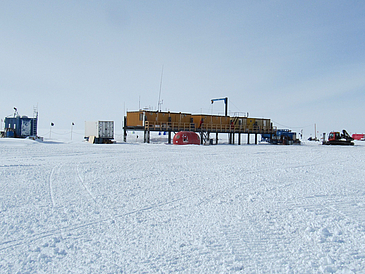Over past decades, the mean temperature on the Earth’s surface has been noticeably rising. What we call “climate warming” is to a large extent due to anthropogenic emissions of CO2 that amplify the natural greenhouse effect. Observations, though, show that there has been hardly or almost no increase in the surface temperature of inland Antarctica over the same period. Scientists from the University of Bremen and the Alfred Wegener Institute in Bremerhaven have been trying to find out why Antarctica should constitute an exception to the global greenhouse effect. They have now published the results of their research based on satellite surveys and radiative transfer calculations in an article for the journal “Geophysical Research Letters”.
The natural greenhouse effect
The Earth is warmed up by the visible radiation it absorbs from the sun’s rays. As a consequence, the Earth then irradiates part of the radiation it receives. However, due the Earth’s considerably lower temperature in the infrared spectral range compared to the sun, this takes place in the form of heat radiation. And this is absorbed by the water vapor and CO2 in the atmosphere which, in turn, irradiates the heat not only into space but also back down to the ground. The reflection of heat from the atmosphere subsequently warms the Earth’s surface in addition to the effect exerted by direct radiation from the sun. This process is called the natural greenhouse effect. It contributes towards maintaining a mean surface temperature of +15 degrees Celsius. In the absence of this process, the mean temperature would be around –18 degrees Celsius.
As a rule, when there is an increase in the concentration of CO2 the atmosphere will absorb more heat radiation, and subsequently irradiate more heat to the ground and less into space. This relationship is known as the anthropogenic greenhouse effect, and it is the main cause of the global warming we are currently experiencing.
What's special about the inner Antarctica?
However, this only happens when the Earth’s surface temperature is higher than in the upper air strata. In the high Antarctica plateau over 300 meters, though, the annual mean temperature is lower than that in the stratosphere. In these regions, therefore, an increase in the concentration of CO2 leads to an increase in the long-wave irradiation into space. Scientists from the Alfred Wegener Institute Helmholtz Center for Polar and Marine Research (AWI) in Bremerhaven and from the University of Bremen’s Institute for Environmental Physics have done some in-depth research into this phenomenon. They base their findings on satellite data and simple model calculations. The results show that increases in the concentration of CO2 in Antarctica are not comparable with processes that take place in the Earth’s temperate zones. The climate researchers have now published their findings in an article for the journal “Geophysical Research Letters”.
Climatic change still proceeds
However, the findings of their research do not explain precisely where the energy loss in the system Earth surface/atmosphere is felt. In other words, it doesn’t reveal whether or not it actually leads to a cooling of the Earth’s surface. This is now the topic of further model calculations. It should be noted that the new findings do nothing to alter our understanding of the greenhouse effect in the rest of the world when increases in CO2 lead to climate warming. The physical processes are identical everywhere. Notwithstanding, the high plateau of inland Antarctica occupies a special position due to the extremely low temperatures there.
The Publication
Holger Schmithüsen, Justus Notholt, Gerd König-Langlo, Peter Lemke, Thomas Jung. How increasing CO2 leads to an increased negative greenhouse effect in Antarctica. Geophysical Research Letters, in press, 2015. doi: 10.1002/2015GL066749.
For more information on this topic, please contact:
University of Bremen
Faculty Physics / Electrical Engineering
Institute for Environmental Physics
Prof.Dr. Justus Notholt
Tel: +49 421-218-62190
Mobil: +49 176-30346533
E-Mail: jnotholtprotect me ?!uni-bremenprotect me ?!.de

